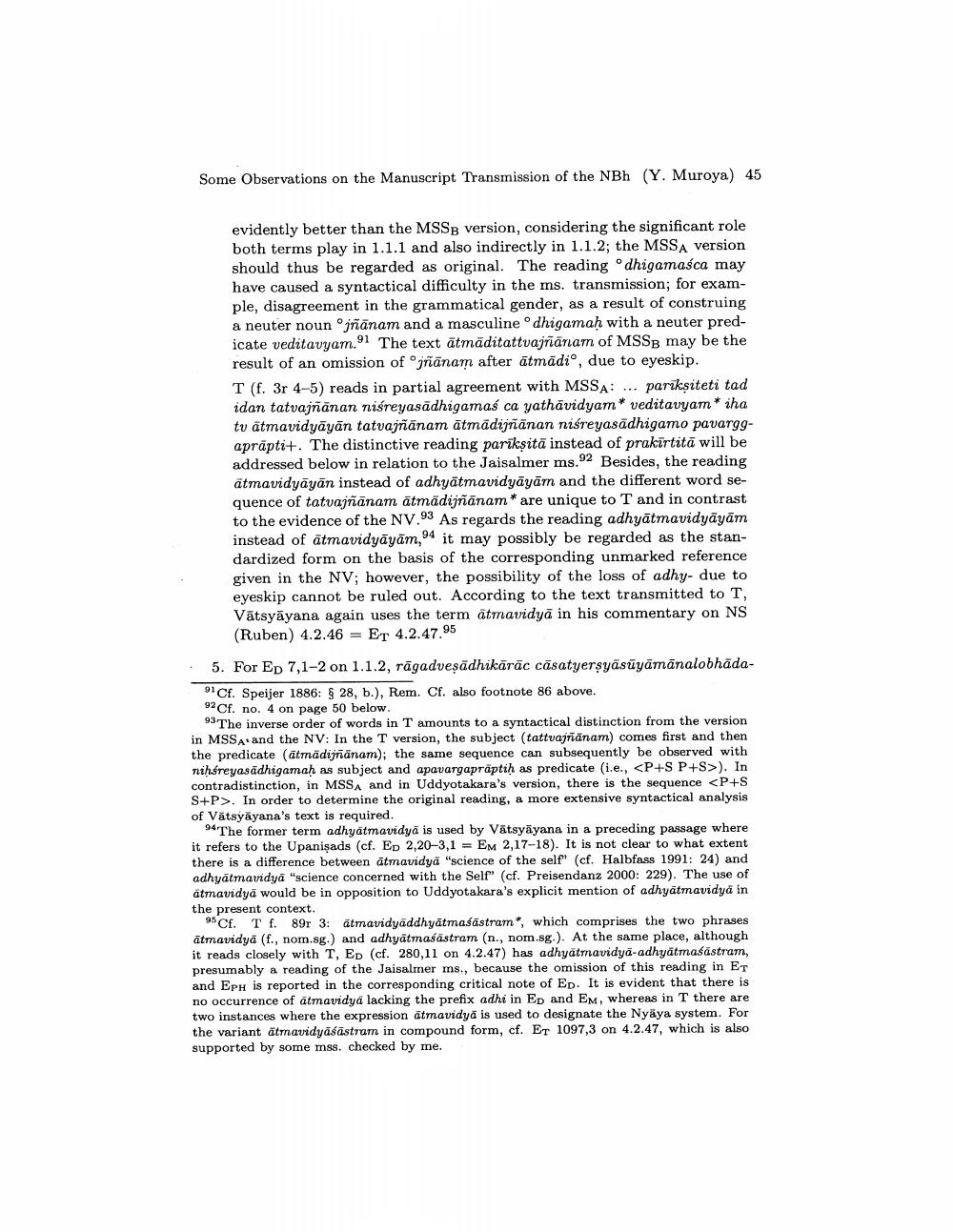________________
Some Observations on the Manuscript Transmission of the NBh (Y. Muroya) 45
evidently better than the MSSB version, considering the significant role both terms play in 1.1.1 and also indirectly in 1.1.2; the MSSA version should thus be regarded as original. The reading "dhigamasca may have caused a syntactical difficulty in the ms. transmission; for example, disagreement in the grammatical gender, as a result of construing a neuter noun jñānam and a masculine odhigamah with a neuter predicate veditavyam.91 The text ātmāditattvajñanam of MSSB may be the result of an omission of jñānam after ātmādi", due to eyeskip. T (f. 3r 4-5) reads in partial agreement with MSSA: ... pariksiteti tad idan tatvajñānan niśreyasādhigamaś ca yathāvidyam* veditavyam* iha tu atmavidyāyān tatvajñānam ātmādijñānan niśreyasādhigamo pavarg9aprāpti+. The distinctive reading parīksitā instead of prakirtitā will be addressed below in relation to the Jaisalmer ms."2 Besides, the reading atmavidyāyān instead of adhyātmavidyāyām and the different word sequence of tatvajñānam ātmādijñānam* are unique to T and in contrast to the evidence of the NV.93 As regards the reading adhyātmavidyāyām instead of atmavidyāyām,94 it may possibly be regarded as the standardized form on the basis of the corresponding unmarked reference given in the NV; however, the possibility of the loss of adhy- due to eyeskip cannot be ruled out. According to the text transmitted to T, Vätsyāyana again uses the term atmavidya in his commentary on NS (Ruben) 4.2.46 = ET 4.2.47.95
5. For Ep 7,1-2 on 1.1.2, rāgadvesādhikarāc cäsatyersyäsüyāmānalobhada"Cf. Speijer 1886: $ 28, b.), Rem. Cf. also footnote 86 above. 92Cf. no. 4 on page 50 below.
93 The inverse order of words in T amounts to a syntactical distinction from the version in MSSA and the NV: In the T version, the subject (tattvajrianam) comes first and then the predicate (ātmādijñānam); the same sequence can subsequently be observed with nihsreyasādhigamah as subject and apavargaprāptih as predicate (i.e., <P+S P+S>). In contradistinction, in MSSA and in Uddyotakara's version, there is the sequence <P+S S+P>. In order to determine the original reading, a more extensive syntactical analysis of Vätsyāyana's text is required.
* The former term adhyatmavidyā is used by Vātsyāyana in a preceding passage where it refers to the Upanişads (cf. Ep 2,20-3,1 = EM 2,17-18). It is not clear to what extent there is a difference between atmavidyā "science of the self" (cf. Halbfass 1991: 24) and adhyātmavidyā "science concerned with the Self" (cf. Preisendanz 2000: 229). The use of atmavidyā would be in opposition to Uddyotakara's explicit mention of adhyatmavidya in the present context.
9 Cf. T f. 89r 3: atmavidyāddhyātmaśāstram*, which comprises the two phrases atmavidyā (f., nom.sg.) and adhyatmasastram (n., nom.sg.). At the same place, although it reads closely with T, ED (cf. 280,11 on 4.2.47) has adhyatmavidyā-adhyatmaśāstram, presumably a reading of the Jaisalmer ms., because the omission of this reading in ET and Eph is reported in the corresponding critical note of Ep. It is evident that there is no occurrence of atmavidya lacking the prefix adhi in Ep and Em, whereas in T there are two instances where the expression atmavidyā is used to designate the Nyaya system. For the variant atmavidyāśāstram in compound form, cf. ET 1097,3 on 4.2.47, which is also supported by some mss. checked by me.




